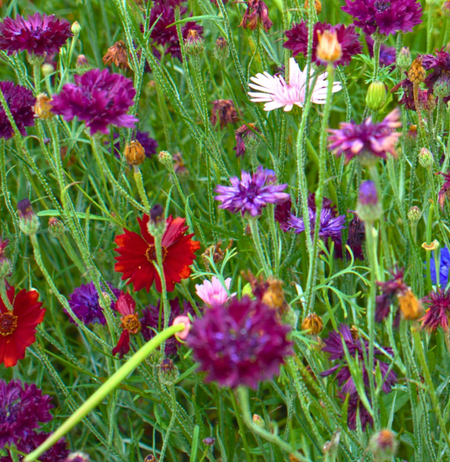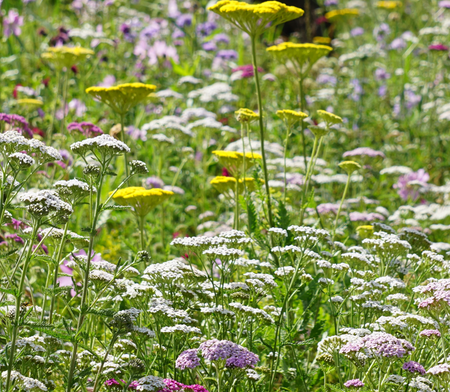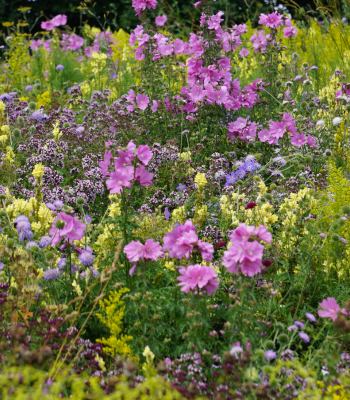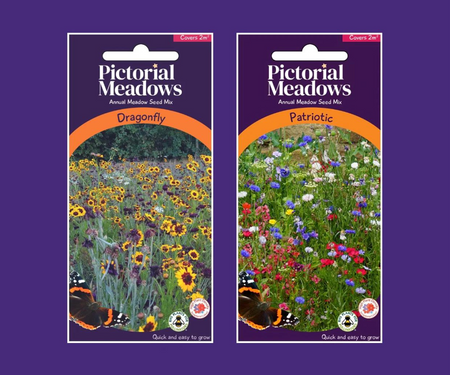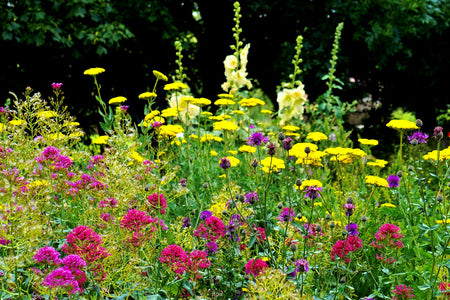Sowing Times and Conditions
When
Perennial seeds can be sown between September and May. The best time to sow perennial seeds is autumn, specifically any time from early September to November. This is because the ground is workable, there is sufficient rainfall, and the seeds benefit from a colder spell to aid germination in spring. Perennial seeds can also be sown throughout winter and spring if the soil remains workable. Avoid sowing in late spring unless you can provide plentiful, regular irrigation.
Where
Most Pictorial Meadows perennials do best if sown in full sun and free-draining soils, with the exceptions of Woodland Edge and Water’s Edge, which will cope with semi-shade and wetter conditions respectively.
All our perennials are designed to adapt to quite a wide range of soil types, but soils and location make a difference in how each meadow will evolve and change over time. Do check out our Seed Brochure so that you can best match a perennial mix to your location.
Ground Preparation
Weeds
Getting a spotless seedbed before sowing is essential. This means removing all visible weeds, including all grass. Do not sow into existing grass or other vegetation, as this will lead to failure.
Soil Preparation
Once the ground is weed and vegetation-free, it will then need cultivating so that a seedbed can be achieved. Keep this cultivation as shallow as you can, just enough to be able to rake the soil and get a surface texture that is level and looks a bit like breadcrumbs.
Mulch
Seed-sown perennials don’t do well if there is a lot of weed competition in the first year. If you suspect your soil is not clean of both visible weeds and the less visible weed seed bank, then it makes a substantial difference to the long-term meadow success if you sow the seed onto a sterile mulch. The function of a mulch is to help suppress the germination of annual seeds that can be in the underlying soils. It will need to be spread evenly over the prepared seedbed to an average depth of 100 mm, just before sowing. Different compost-based materials can be used, but we also recommend clean sand for this purpose as it’s readily available, sterile and cost-effective.
Sowing Your Seed
The sooner you sow seed after getting your ground prepared, the better. Bare, cultivated soil is a magnet for weed seeds to make their home, so make sure you get your perennials in first.
Sowing Rate
Pictorial Meadows perennials should be sown at a rate of 2g per square metre. Most sites can be sown quite successfully and quickly by hand, but you can also contact us for our machine meadow sowing services for larger areas or wherever you feel needs some specialist help.
Check Your Measurements
Always double check when ordering your seed. You don’t want to waste any seed by having far too much or finding you have underestimated and can’t finish the sowing. If you have done this right, but you worry that your seed packet looks tiny – don’t panic! Our mixes are very carefully formulated to cover the area you’ve measured. Trust us and don’t be tempted to sow a larger amount.
For Hand Sowing
Whatever the scale, it is best to mix your seed thoroughly with an inert bulking material such as sawdust, coir or builders’ sand, and then divide the whole amount into two or three separate containers. One portion of the mixed seed and bulking material is then hand-scattered over the entire area. Then take the next portion and repeat but walking in a different direction. This allows you to put a little more or a little less on areas that need it. If this is the first time you have done this, then the last portion allows you to fill any obvious gaps.
Firming
For both autumn and spring sowings, we recommend firming the seeds into the soil after sowing to ensure good contact between the seeds and moisture in the soil. Use a roller, the back of a rake or even the bottom of your shoes to firm the seeds into the soil.
Establishment
For Pictorial Meadows perennials, we consider the first whole growing season as the establishment period – from sowing the seed right through to the end of season cut and collect. The more you invest in the establishment year, the more you will enjoy a long-term impact. It takes skill, attention to detail and some very timely interventions to establish a great perennial meadow from seed.
Watering
If you experience warm, dry weather between the end of April to late June, then irrigation will make a considerable difference to the long-term success of your meadow. This may not be necessary in most years as there is enough rainfall, but the small seedlings are sensitive to lack of moisture. The best irrigation technique is to provide a thorough soaking every four days if there is no natural rainfall.
Growth
Germination will only take place when there is sufficient moisture and warmth in the soil. Germination is much slower compared to annuals, with many species emerging at different times. However, in a regular British year, most seedlings will appear in late spring to early summer onwards.
Weeding
Pictorial Meadows perennials really benefit from very active weed control in the establishment year. The less weed contamination there is, the more the desirable species will thrive, eventually forming a strong root, leaf and flower canopy that helps deter weeds in future years. Weed control shouldn’t be much of an issue if preparation has been thorough, but even with the best preparation, weeds will always invade bare soil.
Frequent hand pulling of any visible weeds is strongly recommended. This is best done just before the meadow is about to flower and where there is a scattering of visible weeds. Quite large areas can be treated by hand pulling; the benefits of this are that the flowers go on to have maximum impact and the ground remains uncontaminated with weed seed for years to come.
Where soils have not been well prepared in advance and/or a large weed seed bank becomes evident after sowing, the best approach is to cut the tops off the carpet of weeds with some form of mower. The native weeds typically appear before the Pictorial Meadow seedlings, so the ideal timing for this will be when there is a canopy of weed leaves standing 2-3 inches high. Cutting on a high setting will significantly check the growth of weed seedlings and stop them setting seed whilst allowing the sown meadow to emerge largely undamaged.
Establishment Cuts
We recommend doing two or three mid-season establishment cuts for our perennial meadows. An establishment cut checks any invading annual weeds and stops the faster growing or emerging perennials from dominating. Essential light and water reach the slower growing species and allows them to catch up. It also encourages basal shooting and stronger root development, which in turn helps to close out bare ground.
We suggest letting the seedlings grow to about 5 inches in height, then cutting back to about 3 inches using a mower on a high setting. Collect and remove as much of the cut material as possible. Although this will reduce the flowering display in the first year, it will encourage the development of healthy plants to ensure successful displays in the future.
If you don’t want to do establishment cuts because you are keen for a flowering display in the first year, the perennial mixes contain a small proportion of annuals that will give colour in the first season. However, if there are annual weeds and growth is fast indicating a fertile soil, we do recommend establishment cuts to create the best meadow long term.
End of Season Cut and Collect
For the first establishment year, it is best to cut and collect in autumn, between September and the first frosts. Although your flowers might still be looking lovely, a cut and collect now will help the slower-growing species to thicken up before the winter, ensuring another successful display next year. All arising material should be collected or raked off and removed from the site.
Ongoing Maintenance
Second Year Onwards
Expect to start seeing the more robust long-lived flowering plants emerging, but at the same time, you will also see the happy self-seeders spontaneously reappearing in gaps, edges and disturbed ground to add seasonal magic to your ever-evolving landscape. Exactly how your perennial meadow will look over time will depend on the location and how much effort and expertise you put into establishing and managing it. Every seed-sown perennial meadow will be unique!
Weed Control
Where you want to do very little or no weed control at all, you should expect wild grasses and plants to invade year on year, with the look becoming increasingly more like a flower-rich countryside verge.
Where you want to take on a more direct approach and keep weeds to a minimum by pulling or cutting, your meadow will look more like an informal herbaceous border. You will likely find the amount of weeding needed will decrease over the years as the weed seed bank is depleted.
Cut and Collect
The one task common to all perennial meadow displays is an end of season cut and collect. This controls weed invasion, including woody plants. It also promotes fresh basal shooting of desirable plant species as well as helping to continually lower soil fertility. The cut and collect can occur any time after flowering has finished and the meadow has become visually unacceptable. This typically means from November to early February.
Encourage Biodiversity
Leaving seed heads and stalks throughout the winter provides a better wildlife habitat for winter birds, small mammals and insects. The dead stems can also look attractive, especially with frost. All the flower stalks have dried out by early February, making removal and disposal much more straightforward. One other significant benefit is that by keeping a canopy of old flower stalks over the meadow, bare soil is less open to weed invasion. Late January/early February is the latest the meadow should be cut to make way for new growth in early spring.
Repeat Flowering
Looking to create different effects and repeat flowering? Don’t be afraid to introduce mid-season mowing along the edges or even right through the middle of your meadow. Both late April and early June ‘differential’ cuts (also known as the Chelsea chop) work well. The cut rejuvenates the meadow, resulting in lovely fresh, neat foliage and usually prompting a second flush of later flowering. Introducing different heights also encourages certain species to find just the perfect spot to thrive.
Top Tips
Check Your Measurements
Always double check when ordering your seed. You don't want to waste any seed by having far too much or finding you have underestimated and can't finish the sowing. If you have done this right, but you worry that your seed packet looks tiny, don't panic! Our mixes are very carefully formulated to cover the area you've measured. Trust us and don't be tempted to sow a larger amount.
Keep Weeds Controlled
Seed-sown perennials don't do well if there is a lot of weed competition in the first year. If you suspect your soil is not clean of both visible weeds and the less visible weed seed bank, then it makes a substantial difference to the long-term meadow success if you sow the seed onto a sterile mulch. The function of a mulch is to help suppress the germination of the thousands of annual seeds that can be in the underlying soils. It will need to be spread evenly over the prepared seedbed to an average depth of 100 mm, just before sowing. Different compost-based materials can be used, but we also recommend clean sand for this purpose as it's readily available, sterile and cost-effective.
Repeat Flowering
Looking to create different effects and repeat-flowering? Don't be afraid to introduce mid-season mowing along the edges or even right through the middle of your meadow. Both late April and early June 'differential' cuts (also known as the Chelsea chop) work well. The cut rejuvenates the meadow, resulting in lovely fresh, neat foliage and usually prompting a second flush of later flowering. Introducing different heights also encourages certain species to find just the perfect spot to thrive.
Let the Experts Help You
Meadows Consultancy
Our specialist meadows team install many Pictorial Meadows across the country for local authorities, public and private clients, together with landowners requiring a guaranteed and dramatic display. If you want to use our meadow consultancy, establishment and maintenance service, contact us for an appointment to discuss your requirements.
Frequently Asked Questions
Are perennial meadows by seed relatively easy to grow, especially if I have little gardening experience?
No, perennial meadows from seed, whilst cost effective and stunning, are not the easiest solution for less confident gardeners to start with. Consider starting with an annual meadow or using Pictorial Meadows turf if you do not want to be very actively engaged in careful preparation and establishment.
When is the best time to sow perennial seeds?
The best time to sow perennial seeds is autumn, specifically anytime from early September to November. This is because the ground is workable and the seeds benefit from a colder spell as it aids spring germination. They can also be sown throughout winter and spring if the soil remains workable. Avoid summer sowing unless you can provide plentiful, regular irrigation.
Does the sowing time for perennial seed impact how quickly I will have a flowering meadow?
Not really. Autumn and winter sowing is beneficial because it provides an important chilling period that helps more seeds germinate in spring. Whatever the sowing time though, vigorous establishment growth won’t happen until the soil really starts to warm up – normally from April onwards. Spring/summer sowings can give you rapid germination if the soil is warm and moist, but a greater percentage of seed may remain dormant until autumn or the next spring. In general, though, whatever the sowing time, you should start to enjoy some colour by mid-summer, although the main impacts won’t be experienced until the second growing season.
Can I mix annual seed with perennial seed?
We don’t advise this. All our perennial mixes already contain a very small percentage of a few select annuals, but we keep this amount to the bare minimum. If you are trying to establish a proper perennial meadow, unless it is on extremely low fertility soils, annuals in any greater amounts will very quickly out-compete and overshadow the slower emerging perennials. Ultimately this prevents a successful long-term sward establishing.
Will my meadow look exactly like the pictures I have seen?
No, even though the mix recipe will be the same, everyone’s meadow will develop its own unique characteristics, and these will continue to change throughout the year, and year to year.
Do I need to protect the seed from mice, squirrels and birds?
Only very rarely. We have sown hundreds of meadows that have never shown any predation by birds or other animals but that doesn’t mean it can’t ever happen.
Will soil fertility affect my perennial meadow?
Yes, it will. Many Pictorial Meadows mixes have been specially designed to perform on normal fertility soils common to most gardens and parks whilst others are only recommended for lower fertility soils. The richer the soil, the taller and bushier the plants will be, especially in the first few years. It is best to select a mix to start with that best suits your soil, to sustain the annual cut and collect, and to bring in an additional early summer cut and collect in some cases if growth is too vigorous. Removing the cut material will gradually reduce the fertility of the soil. After a few years on even the most fertile soils, you will see the composition and structure changing and the emerging meadows look finer and shorter.
Can I sow my perennial seeds over existing grass?
No. Not starting with clean cultivated soils which are especially clear of grass is probably one of the greatest reasons why young perennial seed-sown meadows fail. Always sow on bare, clean, cultivated soils.
Can I mix the perennial seed with grass to make it go further?
No. Grass is very competitive and will quickly dominate all the slower growing perennial seedlings. It is almost impossible to keep wild grasses spreading into meadows over time, so you will eventually get some grass. The less you have, especially in the first few years whilst the perennial plants are getting well established, the better.
Do I need to irrigate my perennial meadow seeds and seedlings?
Yes, irrigation can make a very big difference to perennial meadow success. The critical period is late spring to mid-summer whilst the bulk of the young seedlings are emerging. Once you can see a good range of species establishing and the ground is starting to look more green than brown, irrigation can stop.
What happens if I sow less or more than the recommended rate?
It’s best to stick to the 2g per square metre rule as that’s how we’ve formulated the meadow designs. Do not under-sow a perennial meadow as you won’t get the all-important number of species to grow and cover the ground.
Is it necessary to sow onto sterile mulch?
No, but it can make a very significant difference to the success of your perennial meadow. Whilst you won’t be able to spot them, natural soils can contain huge quantities of weed seeds. Many lie dormant for years, but when brought closer to the surface as you prepare your ground to sow your perennial meadow, these weed seedlings will also start to grow and can very quickly swamp your slower meadow seedlings. A sterile, low fertility mulch will sit on top of your cultivated soil, acting as an effective weed seed barrier. You then sow your perennial seed onto the top of it. This also gives you confidence that all the seedlings you then see emerging are the desirable ones.
Are establishment cuts in the first year necessary?
No, but it can make a very significant difference to the success, especially the species diversity of your perennial meadow. Every species in your mix needs a slightly different set of triggers that allow it to germinate and grow. We formulate the mix carefully to encourage the greatest range of species to all thrive together, but it is necessary to check the faster and bushier ones to allow slower and finer ones to get a foothold. An establishment cut checks any invading annual weeds and stops the faster growing or emerging perennials from dominating. Essential light and water reach the slower growing species and allows them to catch up. It also encourages basal shooting and stronger root development, which in turn helps to close out bare ground. Once you get to the end of the first growing season and there is a good range of species present, they are all remarkably resilient, but they really do need this initial helping hand.
Do you ship worldwide?
No, but you can purchase the Pictorial Meadows seed mixes through our European agents Florum DK and Bloomingfields.

